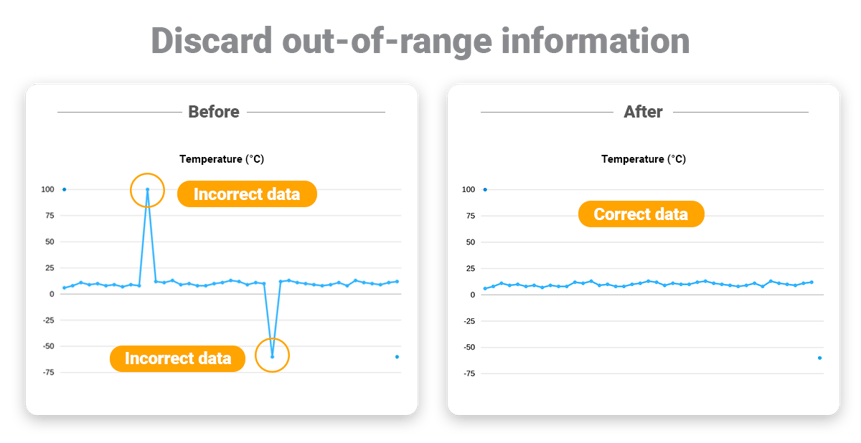Despite all the advantages offered by GPS tracking and telematics, no technology is infallible, and sometimes GPS devices or sensors send unreal data to the tracking platform. For example: when a temperature sensor is reporting within a range of 20 to 25 °C and suddenly, its value changes abruptly to 100 °C, even though the vehicle is at room temperature.
This increase, in addition to being physically impossible, unless the vehicle is on fire, doesn't occur gradually but suddenly and immediately returns to normal values. This causes significant problems for asset fleets and GPS tracking companies. What will a fleet manager think when they see that the fuel sensor reports that the tank is empty, and within 5 minutes of driving, it returns to normal values, or that one of their cranes reports a speed of 200 km/h when they know it's impossible because the crane doesn't reach speeds of more than 100 km/h?
Some examples of how this is reflected on the platform are shown in the image below, where you can see the abrupt values recorded by the sensors:

In addition to the loss of your client's trust in technology and your service, this can cause problems and misunderstandings with drivers, resulting in everything contrary to the benefits your client should receive. What can you do to avoid this problem? Keep reading this article.
Why Does This Happen?
The reasons are diverse, but we'll list some of the most well-known ones:
- Installation problems of GPS devices and sensors or due to sabotage.
- Poor programming of GPS devices, causing the device to report with weak GPS signal or few satellites.
- Sensor calibration problems.
- Use of low-cost GPS devices and/or sensors.
- GPS coverage problems in specific situations, such as entering tunnels or covered parking lots, etc.
What Are the Most Common Failures?
- Unrealistic speeds: some GPS devices report speeds that the vehicle cannot possibly achieve, like 200 km/h for heavy machinery.
- Zero value in the fuel tank: it's possible that fuel sensors send reports of zero, even when there's liquid in the tank.
- Erroneous temperatures: sometimes, temperature sensors send incorrect values for their environment.
All of the above are a source of problems for any company that hires or provides GPS tracking services. Accuracy is essential for all fleets using this technology as a source of operational data. These situations put your service in question and the credibility of your company, which is why we've created a tool that enhances the user experience of satellite tracking services.

Let's take the example of transporting refrigerated goods; cold chain logistics is challenging because it requires transported products to remain refrigerated or frozen without temperature changes. However, it can happen that when an asset's engine is turned on or off, its electronic components generate electrical noise that affects temperature sensors, resulting in voltage variations sent to the platform, leading to the recording of unrealistic temperatures. If your client is a fleet that transports this type of merchandise for a supermarket chain, this can lead to the rejection of the cargo because it's believed to be spoiled, which is not true and creates significant problems, all due to hardware failures.
This is a very common issue that is difficult to prevent because we cannot control all these aspects, and we do not notice hardware malfunctions until they actually fail. So, how can we address this issue? How can we anticipate situations in which, for one reason or another, the hardware does not report the data it should?
The Answer Lies in the Software
In situations where we cannot have total control over the hardware, software helps solve this problem. At RedGPS, as providers of a White-Label GPS tracking platform, we have always had to design algorithms to smooth out hardware issues. The novelty is that with the tool we are introducing now, each of our clients can solve these problems in the way that best suits their business.
On the platform, you can now define the sensor's operating range. This way, minimum and maximum values are set for the sensors to prevent them from reporting physically impossible data (like 100 °C at room temperature). This solution will not eliminate 100% of the erroneous data from a sensor or GPS device, but what it allows is to prevent the reception of unreal data due to hardware failures.
 In cases where the reported value cannot be modified, such as speed (a parameter that is typically default in GPS devices), RedGPS has implemented an enhancement that allows you to add parameters to the asset and treat them as sensors. With this functionality, you can establish the speed parameter as if it were a sensor and set its operating range.
In cases where the reported value cannot be modified, such as speed (a parameter that is typically default in GPS devices), RedGPS has implemented an enhancement that allows you to add parameters to the asset and treat them as sensors. With this functionality, you can establish the speed parameter as if it were a sensor and set its operating range.
Finally, to make this tool transparent to your client and avoid confusion, you can configure that the sensor data that goes beyond the operating range is discarded and replaced in the same data frame by the last valid data.
Benefits
These new features are designed to prevent problems caused by hardware for your GPS tracking company when using our platform. Thanks to them, you can reduce the uncertainty caused by unreal data and avoid misunderstandings and questions about the quality of your service, in addition to other additional benefits like saving time for your support team.
We view these features as a double check to validate the data and enhance the platform experience, as an extra layer that ensures the accuracy of the data we receive and process. At RedGPS, we believe that a GPS tracking platform should also contribute to solving hardware issues. Do you have questions about these new features? You can contact your Account Manager to learn more. If you're not yet our client and are interested in learning more about RedGPS and all the functions we can offer to your company, complete the form located at the end of this article, and one of our advisors will contact you.
You May Also Be Interested In 
|
|

5 Benefits of Real-Time GPS Tracking for your business |

GPS Tracking Focused on Security: Guide 2023 |









